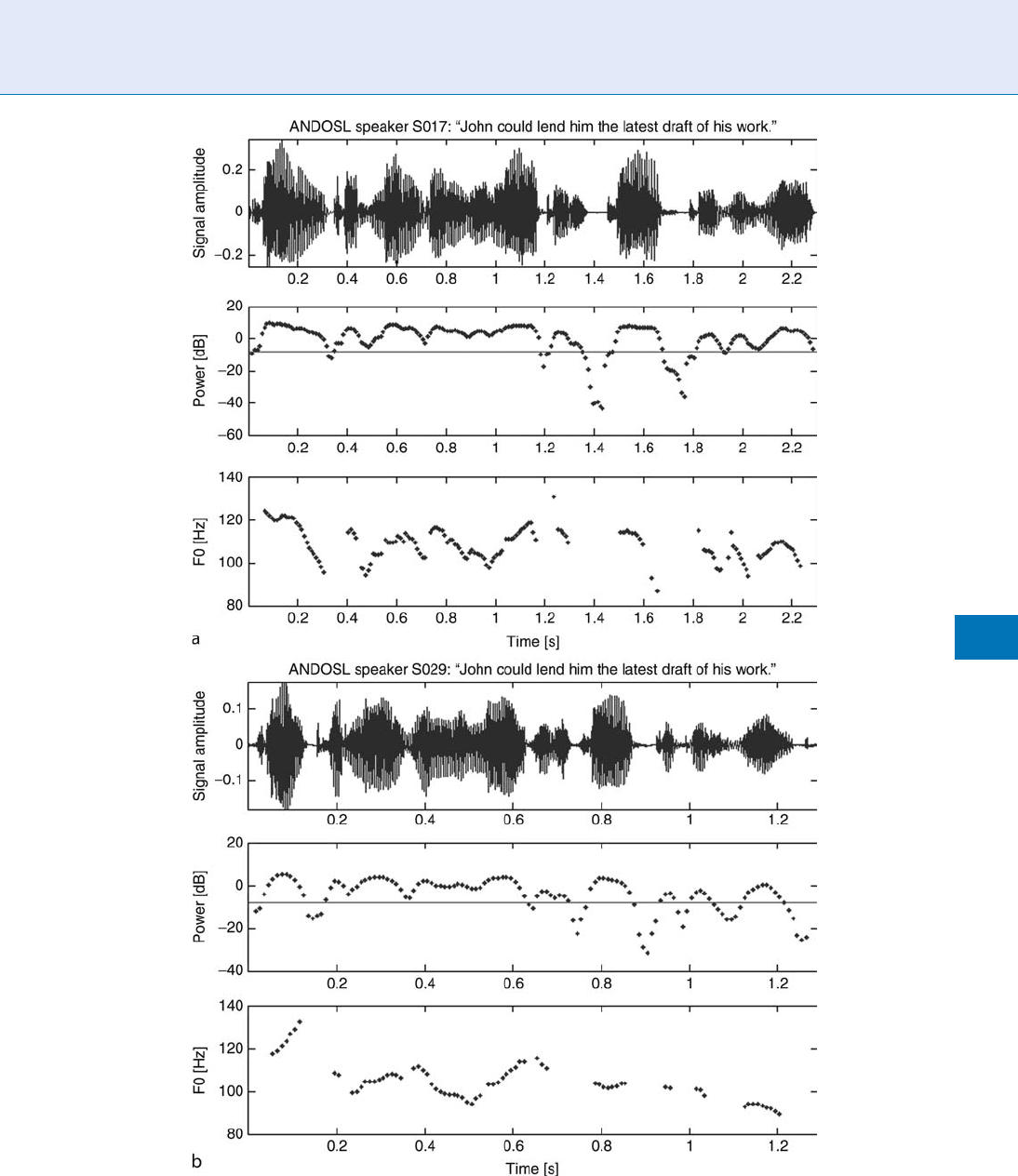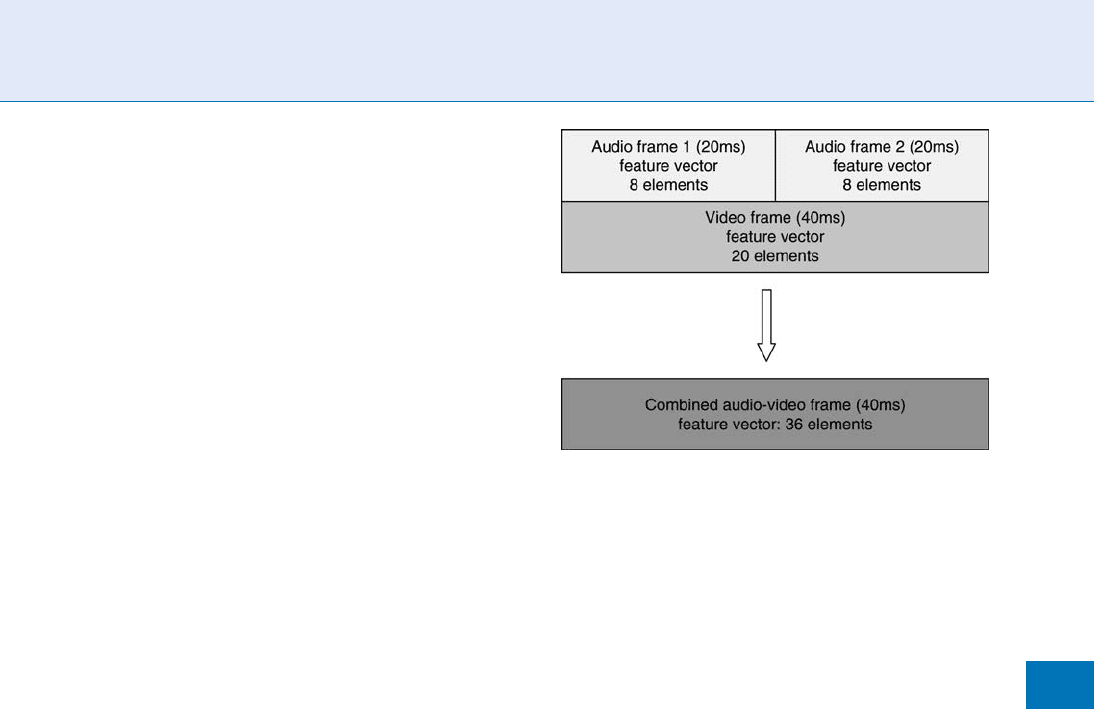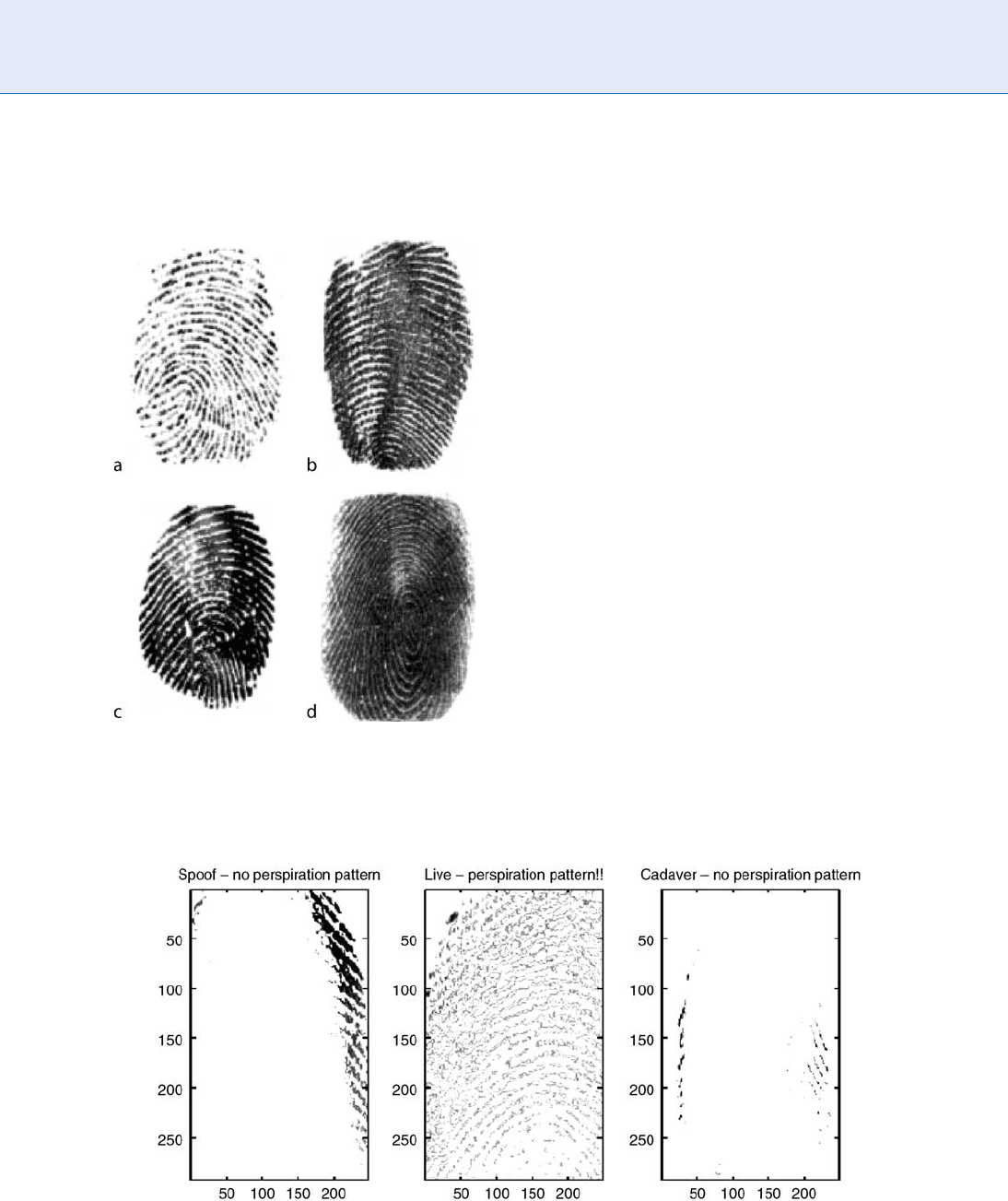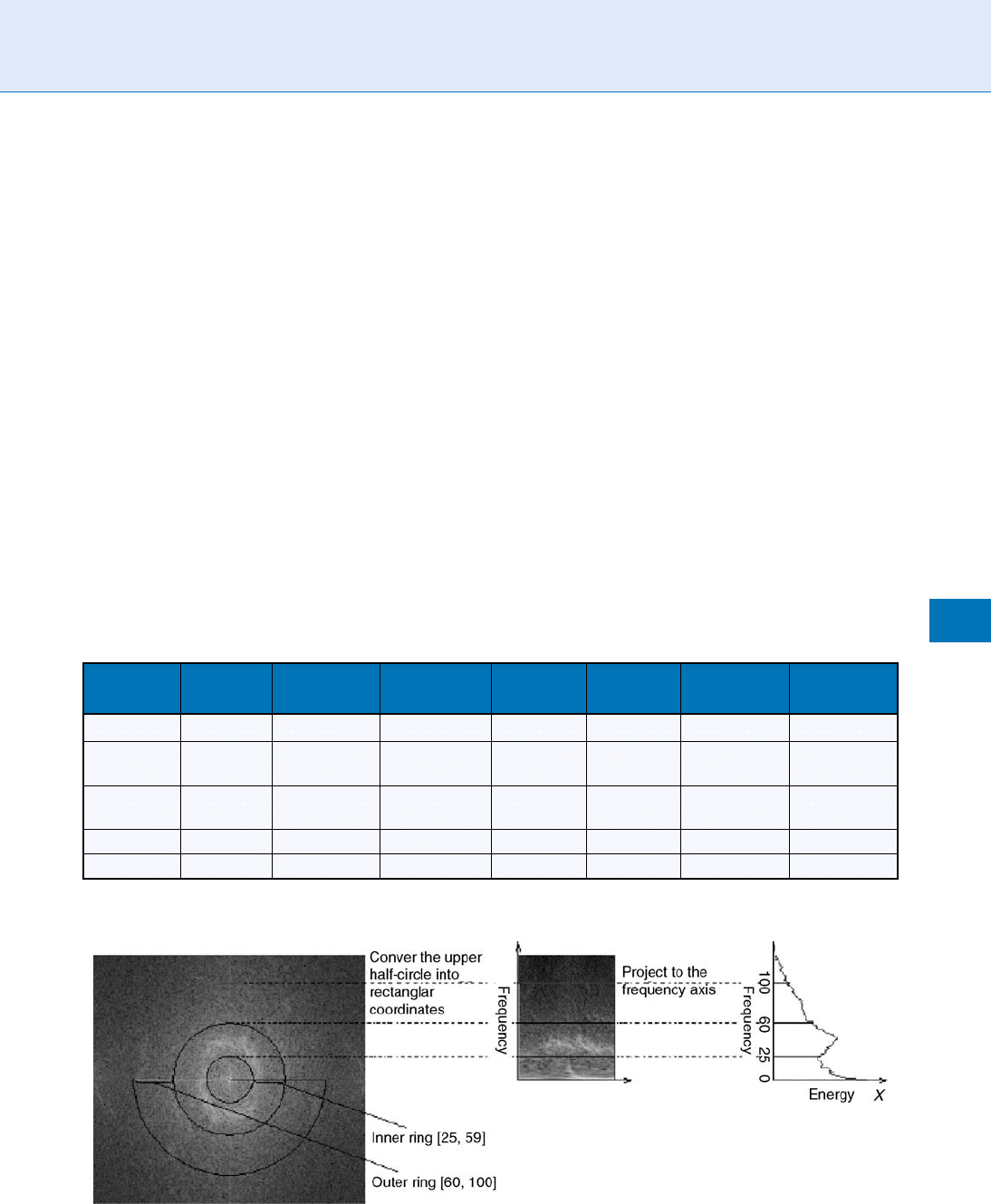Li S.Z., Jain A.K. (eds.) Encyclopedia of Biometrics
Подождите немного. Документ загружается.


voice of the target speaker. In practice, however, cur-
rent state-of-the-art text-to-speech synthesis is not
quite capable of producing such natural sounding
utterances. In other words, synthetic speech produced
by current TTS systems still sounds far from natural
and is easily distinguished from genuine human speech
by the human ear. Does this mean, however, that TTS
speech could not deceive an authentication system
based on automatic speaker recognition? To answer
this question, it needs to be examined how different
speaker recognition systems actually work.
As shown in Table 1, there are three types of speaker
recognition systems that are distinct by the types of
speech patterns each examines in order to determine
the similarity of the unknown speech and the target
speech. The most common type of speaker recognition
system looks at speaker differences at the individual
sound level. A second type of speaker recognition
system examines the sequences of speech sounds,
which form words, and a third type also analyzes
higher-level information such as intonation, choice
of words, choice of sentence structure or even semantic
or pragmatic content of the utterances in question [4].
Speech processing invariably segments a speech
signal into small chunks, or ‘‘frames’’, which corre-
spond in duration roughly to short speech sounds,
say about 10–30 ms. For each frame, features are
extracted from the speech signal, such as a spectrum
or a cepstrum or a mel-frequency cepstrum (MFC) [5].
These extracted features serve as the basis for the
comparison between the unknown speech and the
target speech. The first type of speaker recognit-
ion system independently compares the features of
each frame of the unknown speech signal with
the model of the target speaker. This is done indepen-
dently for each frame and without considering the
speech sounds immediately preceding or succeeding
the given frame.
The second type of speaker recognition system
takes into account the likelihood of sequences of speech
sounds, rather than individual speech sounds, when
comparing the unknown speech signal with the model
of the target speaker. For example, the sound sequence
/the/ would be more likely for a speaker of Eng lish than
the sound sequence /eth/. The third type of system
takes into account higher-level features, i.e., the varia-
tion of features over time such as the intonation
pattern of a sentence, as it manifests itself through
the functions of loudness and pitch over time. Such
authentication systems typically operate on much lon-
ger passages of speech, for example, to segment a two-
way telephone conversation or the proceedings in a
court of law into the turns belonging to the different
speakers. Figure 4 shows an example of two speakers
pronouncing the same sentence with quite different
intonation.
It is easy to see that a context-free authenticati on
system is prone to be attacked successfully by a very
simple synthesizer, namely one that produces a few
seconds of only a single speech sound. For example,
an attacker could reproduce a single frame of, say, the
sound ‘‘a’’ of the target speaker and play this frame
Liveness Assurance in Voice Authentication. Table 1 Types of speaker authentication methods
Type of speaker
recognition system Training/Enrolment Testing Typical method
Recognizes
individual speech
sounds (context-
free)
A set of speech sounds typical for
the target speaker is collected and
becomes the ‘‘model’’ for the target
speaker
Each speech sound is individually
compared with the target speaker
‘‘model’’
Gaussian
MixtureModel (GMM)
Recognizes
sequences of
speech sounds
(context-sensitive)
In addition to the individual
sounds, the speaker model
represents the sequences of speech
sounds that are typical for the
target speaker
The entire utterance is compared
with the target speaker model for
both individual sounds and sound
sequences
Hidden Markov Model
(HMM)
Recognizes higher-
level features
(intonation, word
choice, syntax etc.)
In addition to sound sequences, the
speaker model represents words,
sentence structures and intonation
patterns typical for the target
speaker
Similarity of sounds and sound
sequences is combined with
similarity of word sequences and
intonation patterns
Information fusion of
GMM and/or HMM
with higher-level
information sources
920
L
Liveness Assurance in Voice Authentication

Liveness Assurance in Voice Authentication. Figure 4 Two male speakers from the Australian National Database of
Spoken Language (ANDOSL), speaking the same sentence with distinctly different intonation: audio signal, and
power and fundamental frequency (F0) contours. Speaker S017 produced the word John with falling F0, while Speaker
S029 produced the same with rising F0.
Liveness Assurance in Voice Authentication
L
921
L

repeatedly for a second or two in order to ‘‘convince’’
an authentication system of this type that the
‘‘aaaaaaa...’’ sound represents the natural voice of the
target speaker. This is because each frame is assessed
independently as being similar to the ‘‘a’’ sound of the
target speaker, irrespective of the fact that the sequence
of ‘‘a’’ sounds does not represent a likely speech pattern
of the target voice.
A context-sensitive authentication system, on the
other hand, requires a speech synthesizer to reproduce
entire sound sequences that are sufficiently similar to
sound sequences produced by the target speaker. This
means that the individual sounds, produced by the
synthesizer, must be similar to sounds of the target
speaker and the sound sequences must be structured
in a similar way to those of the target speaker. This is a
proposition that is far more difficult, although not
impossible, to achieve with current-state-of-the-art
speech synthesizers. Furthermore, if the speaker au-
thentication system also considers the intonation pat-
tern and higher-level features such as choice of words
and grammatical constructs, an attacker who tries to
impersonate a target speaker using a TTS synthesizer,
would require a system that is beyond the capabilities
of the technology at the time of writing.
Multimodal Liveness Assurance
The assurance that a voice biometric is delivered live at
the time and place of authentication can be enhanced
considerably by complementing the voice modality
with a second modality. In the simplest case, this
could be the visual modality provided by a human
observer who can assure that the voice biometric is
actually provided by the person seeking authentication
and that person is not using any device to play back a
recorded or synthesized voice sample.
In an automatic voice authentication system, simi-
lar assurance of liveness can be achieved by combining
the voice modality with a face recognition system. Such
a system has a number of advantages. Firstly, the bi-
modal face-voice approach to authentication provides
two largely independent feature sets, which, when
combined appropriately, can be expected to yield bet-
ter authentication than either of the two modalities by
itself. Secondly, the bimodal approach will add robust-
ness to the system when either mod ality is affected by
difficult environmental conditions. In the case of bi-
modal face-voice authentication, it is par ticularly use-
ful to fall back on the complementary face recognition
facility when the voice recognition modality breaks
down due to high levels of surrounding noise, compet-
ing speakers or channel variability such as that caused
by weak cell phone reception. In such situations, the
face recognition modality will be able to take over and
hence provide enhanced robustness for the combined
system.
A simila r consideration applies, of course, when the
combined face-voice authentication system is viewed
from the perspective of the face recognition modality,
which may equally break down in difficult environ-
mental conditions such as adverse lighting. In this case,
too, the overall robustness of the authentication system
is preserved by the combination of the two modalities
voice and face, each of which is affected differently and
largely independently by environmental factors.
However, the most important advantage of a bi-
modal face-voice authentication system for the assur-
ance of liveness is the fact that the articulator
movements, mainly of the lips, but also of the tip of
the tongue, jaw, and cheeks are mostly observable and
correspond closely to the particular speech sounds
produced. Therefore, it is possible when observing a
bimodal audio-video signal of the speaking face to
ascertain whether the facial dynamics and the sequence
of speech sounds are mutually compatible and
synchronous. To a human observer it is quite discon-
certing when this is not the case, for example, with an
out-of-sync television signal or with a static facial
image when the speaker is heard saying something,
but the lips are not seen to be moving. In the field of
audiovisual speech recognition, the term ‘‘viseme’’ has
been coined as the visual counterpart of the ‘‘
▶ pho-
neme’’, which denotes a single speech sound. The
visemes /m/, /u/, and /d/ (as in the word ‘‘mood’’),
for example, first show the speaker’s lips spread and
closed (for /m/), then protruded and rounded (for /u/),
and finally spread and slightly open (for /d/). It is
therefore possible to detect whether the corresponding
sequences of visemes and phonemes of an utterance
are observed in a bimodal audio-video signal and
whether the observed viseme and phoneme sequences
are synchronous.
In order for the synchrony of the audio and video
streams to be ascer tained, the two modalities must be
combined appropriately. Multimodal authentication
922
L
Liveness Assurance in Voice Authentication

systems employ different paradigms to combine, or
‘‘fuse’’, information from the different modalities. Mo-
dality fusion can happen at different stages of the
authentication process. Fusing the features of the dif-
ferent channels immediately after the feature extrac-
tion phas e is known as ‘‘feature fusion’’ or ‘‘early
fusion’’. In this paradigm, all comparisons between
the unknown sample and the client model as well as
the decision making are based on the combined feature
vectors. The other possibility is to fuse information
from the two modalities after independent compari-
sons have been made for each modality. Such para-
digms are known as
▶ score fusion, ▶ decision fusion
or
▶ late fusion.
For liveness assurance by means of bimodal face-
voice authentication, it is necessary to apply an early
fusion stratagem, i.e., to fuse the two modalities at the
feature level [6]. If the two modalities were fused late,
i.e., at the score or decision level, analysis of the video of
the speaking face would yield one decision on the speak-
er’s identity and analysis of the audio of the utterance
would yield another decision on the speaker’s identity.
The two processes would run independently of each
other with no connection between them that would
allow the checking for the correspondence and syn-
chrony of visemes and phonemes [7].
Therefore, the features that are extracted from the
audio signal on a frame-by-frame basis – usually at an
audio frame rate of about 40–100 frames per second –
must be combined with the features that are extracte d
from the video signal – usually at the video frame rate
of 25 or 30 frames per second. An example of how the
differing frame rates for the audio and video signals
can be accommodated is shown in Fig. 5, where the
audio frame rate is 50 frames per second, the video frame
rate is 25 frames per second, and the combined audiovi-
sual feature vector comprises the audio feature vectors of
two consecutive audio frames, combined with the single
video vector of the synchronous video frame.
The combined audiovisual feature vectors will then
reveal whether the audio and video streams are synchro-
nous, for example, when the combined audiovisual
feature vectors contain the sequence of visemes /m/,
/u/, and /d/ and likewise the sequence of phonemes
/m/, /u/, and /d/. In contrast, if one of the combined
audiovisual feature vectors were to contain the visual
information for the viseme /m/ and at the same
time the audio information for the phoneme /u/, the
combined feature vector would indicate that the audio
and video streams do not represent a corresponding
synchronous representation of any speech sound.
The proper sequencing of visemes and phonemes
is usually ascertained by representing the audio-
visual speech by Hidden Markov Models (HMM),
which establish the likelihoods of the different com-
bined audiovisual vectors and their sequences over
time [8]. It is therefore possible to ascertain whether
the audio and video components of a combined
audio-video stream represent a likely live utterance.
Therefore, an attacker who attempts to impersonate
a target speaker by means of a recorded speech utter-
ance and a still photograph of the target speaker will
be thwarted because the system will recognize the fail-
ure of the face to form the corresponding visemes that
should be observed synchronously with the phoneme s
of the utterance. Similarly, such a system will thwart an
attack by an audiovisual speech synthesis system, un-
less the synthesizer can generate the synthe tic face and
the synthetic voice in nearly perfect synchrony.
Related Entries
▶ Biometric Vulnerabilities: Overview
▶ Security and Liveness, Overview
▶ Voice Authentication
Liveness Assurance in Voice Authentication. Figure 5
Feature fusion of two consecutive 20ms audio feature
vectors with the corresponding 40ms video feature vector.
Before fusion, the audio vectors have been reduced to
8 dimensions each, and the video vector has been reduced
to 20 dimensions. The combined feature vector has
36 dimensions.
Liveness Assurance in Voice Authentication
L
923
L

References
1. Furui, S.: Cepstral analysis techniques for automatic speaker
verification. IEEE Trans. Acoust., Speech and Signal Processing
ASSP-29, 254–272 (1981)
2. Bimbot, F., Bonastre, J.-F., Fredouille, C., Gravier, G., Magrin-
Chagnolleau, I., Meignier, S., Merlin, T., Ortega-Garcı
´
a, J.,
Petrovska-Delacre
´
taz, D., Reynolds, D.A.: A tutorial on text-
independent speaker verification, EURASIP J. Appl. Signal Pro-
cessing 2004(4), 430–451 (2004)
3. Matsui, T., Furui, S.: Speaker adaptation of tied-mixture-based
phoneme models for text-prompted speaker recognition. In:
Proceedings of International Conference on Acoustics, Speech
and Signal Processing , Adelaide, pp. I-125–128. IEEE Publisher,
New York (1994)
4. Reynolds, D., Andrews, W., Campbell, J., Navratil, J., Peskin,
B., Adami, A., Jin, Q., Klusacek, D., Abramson, J., Mihaescu,
R., Godfrey, J., Jones, D., Xiang, B.: The SuperSID Project:
Exploiting high-level information for high-accuracy speaker
recognition. In: Proceedings of International Conference on
Acoustics, Speech and Signal Processing, Hong Kong, pp. IV-
784–787. IEEE Publisher, New York (2003)
5. Huang, X., Acero, A., Hon, H.-W.: Spoken language processing,
Prentice Hall, Upper Saddle River, NJ (2001)
6. Chetty, G., Wagner, M.: Investigating feature-level fusion for
checking liveness in face-voice authentication. In: Proceed-
ings of eighth IEEE Symposium on Signal Processing and
its Applications, Sydney, pp. 66–69. IEEE Publisher, New York
(2005)
7. Bredin, H., Chollet, G.: Audiovisual speech synchrony measure:
Application to biometrics. EURASIP J. Adv. Signal Process. 2007
(1), 1–11 (2007)
8. Chetty, G., Wagner, M.: Speaking faces for face-voice speaker
identity verification. In: Proceedings of Interspeech-2006 –
International Conference on Spoken Language Processing,
Paper Mon3A1O-6, Pittsburgh. International Speech Commu-
nication Association (2006)
Liveness Detection
Liveness detection is a functionality that determines
whether the presented biometric sample (e.g., finger,
hand, or iris) is originated from a live body. This func-
tionality is considered to be one of the key security
measures that improve the reliability of a biometric sys-
tem because it enables the system to reject artifacts to be
enrolled and ensure that no forged sample is accepted.
▶ Finger Vein Reader
Liveness Detection
In biome tric systems, the goal of liveness testing is to
determine if the biometric being captured is an actual
measurement from the authorized, live person who is
present at the time of capture. While biometric systems
may have an excellent performance and improve secu-
rity, previous studies have shown it is not difficult to
spoof biometric devices through fake fingers, high
resolution images or video, contact lenses, etc. Even
though biometric devices use physiologic information
for identification/verification purposes, these measure-
ments rarely indicate liveness. Liveness detection
reduces the risk of spoofing by requiring a liveness
signature in additi on to matched biometric informa-
tion. Methods can incl ude medical measurements such
as pulse oximetry, electrocardiogram, or odor. In a few
cases, liveness information is inherent to the biometric
itself, i.e., the biometric cannot be captured unless the
user is live, e.g., electrocardiogram as a biometric.
While liveness algorithm makes spoofing more diffi-
cult, they need to be considered as components of a
biometric system which bring with it performance
characteristics, as well as factors such as ease of use,
collectability, user acceptance, universality, spoof-abil-
ity, permanence, and, in some cases, even uniqueness.
No system is perfect in its ability t o prevent spoof-
attacks. However, liveness algorithms can reduce this
vulnerability to minimize the risk of spoofing.
▶ Anti-spoofing
▶ Liveness Detection: Fingerprints
▶ Liveness Detection: Iris
▶ Liveness Detection: Fingerprint
Liveness Detection: Fingerprint
STEPHANIE A. C. SCHUCKERS
Clarkson University, Potsdam, New York, USA
Synonyms
Anti-spoofing; Vitality
924
L
Liveness Detection

Definition
In biometric systems, the goal of liveness testing is
to determine if the biometric being captured is an
actual measurement from the authorized, live person
who is present at the time of capture. While fingerprint
systems may have an excellent performance and im-
prove security. Previous studies have shown it is not
difficult to make molds of latent fingerprints left
by legitimate users and to create fake fingers made
from Play-Doh, gelatin, and silicone materials to fool
a variet y of fingerprint scanners, termed spoofing.
Liveness detection reduces the risk of spoofing by
requiring a liveness signature, in addition to matched
biometric information. Methods can be divided into
hardware and software categories. Hardware methods
include measurements like pulse oximetry, electrocar-
diogram, or odor, while software based measurements
use additional processing of the biometric information
itself to isolate liveness signatures like perspiration and
deformation. While liveness algorithm makes spoofing
more difficult, they need to be considered as compo-
nents of a biometric system, which bring with it per-
formance characteristics along with factors such as
ease of use, collectability, universality, spoof-ability,
permanence, and in some cases, even uniqueness. No
system is perfect in its ability to prevent spoof -attacks.
However, liveness algorithms can reduce this vulnera-
bility to minimize the risk of spoofing.
Fingerprints are graphical ridge-valley patterns from
human fingers. Fingerprint recognition is a widely
used and efficient technique for biometric authentica-
tion. While fingerprint systems may have excellent per-
formance and improve security, previous studies have
shown it is not difficult to make molds of latent finger-
prints left by legitimate users and to create fake fingers
made from Play-Doh, gelatin and silicone materials to
fool a variety of fingerprint scanners [1, 2]. The most
famous of which is the work by Matsumoto and collea-
gues. In the reports, two different techniques were used
to create a mold. The first technique directly used a
subject’s finger to create the mold in free molding plastic,
whereas the second technique involved making a mold
from a latent fingerprint image. Casts were made of
gelatin material and termed ‘gummy fingers’. Verifica-
tion rates of gummy fingers ranged from 68 to 100%. For
method of creating a cast from residual fingerprints, all
fingerprint systems were able to enroll the spoof finger
and verify more than 67% of the attempts. Similar results
have been obtained on subsequent studies with various
materials including silicon, clay, and Play-Doh [1, 2 ],
and one study which looked at cadaver fingers [2].
Currently, International Biometric Group with spon-
sorship from Financial Services Technology Consor-
tium (FSTC) is hosting an effort to conduct spoof
trials with vendor volunteers called SPOOF 2007.
It should be noted that vulnerability to spoofing is
not assessed as part of the false accept ratio, a typical
assessment measure of biometric devices. A false accept
is when a submitted sample is incorrectly matched to
a template enrolled by another user. This only refers
to a zero-effort attempt, i.e., an unauthorized user
making an attempt with their own biometric to gain
access to a system. If the false accept ratio is kept low,
then the probability of specific user with criminal in-
tent matching another template is very low. The false
accept ratio does not give information on the vulnera-
bility of a system to spoof attacks.
Even though biometric devices use physiologic
information for identification/verification purposes,
these measurements rarely indicate liveness. The goal
of liveness testing is to determine if the biometric being
captured is an actual measurement from the author-
ized, live person who is present at the time of capture.
Overview of liveness approaches are described in
[2–5]. Performance of fingerprint liveness to separate
live and spoof fingers is measured by live false reject
rate and spoof false accept rate. Equal error rate
between these two measures and receiver operating
characteristic curves can also be used as described in
Biometric Security Overview. Marcialis et al., provides
a table which compares datasets used for testing and
performance of liveness approaches.
Methods to measure liveness fall into several cate-
gories. In 2007 [6], a taxonomy is presented whereby
methods are divided into soft ware and hardware-
based. A similar division is suggested, but also consider
an additional category where liveness is inherent to the
biometric, i.e., it must be present in order to capture
the biometric [2]. In the first liveness is captured
through additional hardware integrated with the fin-
gerprint sensor. For first category software-based tech-
niques, involves further processing of the biometric
signature to obtain liveness information. For example,
this may mean extracting perspiration information
from fingerprint image. The second software based
approach is where liveness is an inherent part of the
biometric, in other words, the biometric cannot be
Liveness Detection: Fingerprint
L
925
L

captured unless the subject is alive. An example for this
category is the electrocardiogram, which has been sug-
gested as a biometric [7] and where liveness is inherent
to collection of this biometric. Liveness in most cases is
not inherent to be able to measure a fingerprint bio-
metric. Most systems that consider liveness in finger-
print do so through additional software or hardware
processing. Electrocardiogram might be considered a
special case as it has been suggested as an additional
measurement to fingerprint recognition so it can be
considered as hardware liveness approach and it may
be potentially inherent to the biometric if the electro-
cardiogram is used as a biometric.
Hardware
The first method uses extra hardware to acquire life
signs. Previously developed approaches measure finger-
tip temperature, pulse, pulse oximetry, blood pressure,
electric resistance, odor, multi-spectral information, or
electrocardiogram (e.g., [8, 7, 9, 10]). These methods
require dedicated hardware integrated with the finger-
print system. Electrocardiogram is the electrical mea-
surement of the heart collected through elec trodes
on two skin contact points on the body which need
to be on opposite sides of the heart (e.g., two hands,
hand and foot). Pulse oximetry is the measurement
of the oxygen content of the blood through the com-
parison of the absorption of two wavelengths of
light by the blood. This measurement requires a LED
and photodetector on opposite sides of the finger
and typically needs to be shielded from ambient light.
This absorption also varies as the heart be ats and
can be a measure of pulse, and therefore may require
a few seconds to compute to record one or two com-
plete heart beat cycles. A critical component to hard-
ware-based approaches is how the additional hardware
is integrated with the fingerprint sensor. It should be
integrated in such a way that it cannot be spoofed with
any live finger in combination with a spoof.
The following paragraph describes two fingerprint
sensors, multispectral and ultrasound, which naturally
capture liveness information. They are placed here in
the hardware category, because these approaches, while
commercially viable, require purchase of a specific
scanner and are not applicable to standard fingerprint
readers. One commercially available fingerprint sensor
(Lumidigm, USA) uses a multispectral sensor, from
which multiple wavelengths of light and different
polarizations allow new data to be captured, which is
unavailable from a conventional optical fingerprint
reader. Based on the multiple spectral images, they
have developed a spoof detection method [10]. Simi-
larly, ultrasound measurements have been suggested as
a way to measure fingerprint images (Opt el, Poland).
While fingerprint measured by ultrasound might be
able to image a spoof or cadaver fingerprint itself,
using additional information from the ultrasound
measurement would likely be capable of separating
live from spoof images. Both approaches most likely
need additional processing from the fingerprint image
itself to determine liveness.
Software
The second method uses the information already pres-
ent in the fingerprint imag e to detect life signs, for
example, skin deformation, pores, power spectrum,
or perspiration pattern.
Skin deformatio n and elasticity. Skin deformation
technique uses the information regarding how the
fingertip’s skin deforms when pressed against the scan-
ner surface [11–14]. The studies show that when a real
finger moves on a scanner surface, it produces a signif-
icant amount of non linear distortion. However, fake
fingers are more rigid than skin and the deformation is
lower even if they are made of highly elastic materials.
One approach quantifies this considering multiple
frames of clockwise motion of the finger [12]. The
performance of this method has an equal error rate
of 11.24% using 45 live subjects and 40 fake fingers.
A study by Zhang et al. [14] uses a thin-plate spline
distortion model over multiple frames, while the finge r
is moved and resulted 4.5% EER in a dataset of 120
fake fingerprints from silicon from 20 individuals.
Another metho d considers the deformation in a single
image compared to a template [11]. This study
achieved 82% for a small dataset.
Perspiration pattern. Previously, our laboratory has
demonstrated that perspiration can be used as a mea-
sure of liveness detection for fingerprint biometric
systems. Unlike spoof and cadaver fingers, live fingers
demonstrate a distinctive spatial moisture pattern
when in physical contact with the capturing surface
926
L
Liveness Detection: Fingerprint

of the fingerprint scanner. The pattern in fingerprint
images begins as ‘patchy’ areas of moisture around the
pores spreading across the ridges over time. Image/
signal processing and pattern recognition algorithms
have been developed to quantify this phenomenon
using wavelet and statistical approaches [15–17].
These approaches require two time-series images,
which might not be convenient for the users. Other
methods to quantify this phenomenon have been de-
veloped for a single image [18]. Performance has
achieved approximately 10% live/spoof EER for earlier
papers on a dataset of 80 spoof, 25 cadaver, and 58 live
images to perfect separation in later papers on this
small dataset [16].
Characteristics of spoof and live images. A natural
extension to the specific categories above is to begin to
assess the characteristics that define live and spoof
fingers, which cover a broad range [5, 13, 19–21].
Theseincludeimagepowerspectrumthatrevealsstamp
fabrication process [5], noise residue in the valleys
due to spoof material [ 19, 21], and combinations of
multiple factors, for example, fusion of perspiration
and deformation features [13].
Image power spectrum has been considered as an
effective feature for vitality detection [5, 20]. The dif-
ference between live and spoof images is mainly
due to the stamp fabrication process, which causes an
alteration of frequency details between ridge and
valleys. The Fourier transform feature can quantify
the difference in terms of high frequency informa-
tion loss for fake fingers. This approach is tested for
a single scanner and silicone spoof material with
average spoof/live EER of 2.4% on a dataset of
720 fake and 720 live images from 36 individuals [6]
and for gelatin and silicon with an average of 23%
EER for a dataset of 900 fake and 450 live images
from 30 individuals [20].
In other study [13], a sequence of images is used
to measure skin elasticity, but some of the measures
may be capturing perspiration information as de-
scribed above. No special motion is required for
the finger. They achieve results of 4.78% on a dataset
of 470 spoof images from 47 spoof casts and 300
live images from 15 individuals. In a second study,
fusion of multiple features, two based on perspiration
signal and two based on skin elasticity, was performed
in 2007 [22]. Result showed 4.49% EER on the
same dataset.
Liveness Algorithm Framework
Fingerprint liveness algorithms can fall into types de-
scribed above (hardware, software, and inherent).
Other factors that separate liveness algorithms include
(1) dynamic/static, (2) user training, and (3) binary/
user specific. Table 1 compares five fingerprint liveness
algorithms within the context of this framework.
Dy namic or static: Liveness algorithms may require
only one frame or rely on multiple fram es to
measure the dynamic nature of the system to de-
tect liveness [5]. For example, many of the per-
spiration proposed approaches require more than
one image [15], although recent work has used one
image [18]. Other dynam ic approaches are related
to deformation [12–14]. Note that pulse oximetry
do not require multiple fingerprint image frames,
however, they may require more time to record one
or more full hear t cycles.
User training: Some liveness algorithms rely on
specific user actions to determine liveness. This
may include a procedure (deform ation changes
due to rotating the finger), which require user
training [12, 14].
Binary (live/spoof) versus user specific: Liveness
algorithms can be made general across all subjects,
that is, the same algorithm is used for all subjects to
determine liveness producing a binary result: live
or non live (Fig. 1). Other approaches can be made
subject specific, that is, a liveness algorithm is
Liveness Detection: Fingerprint. Table 1 Liveness
algorithm types and factors
a
Hardware/
Software
Multiple/
Single
Binary/
User
specific
User
training
Perspiration S M/Si B/US None
Pulse
oximetry
H – B None
Multi-
spectral
H Si B/US None
Deformation S M/Si B UT or
none
ECG H – B/US UT
a
H Hardware; S Software; M Multiple; Si Single; B Binary; US User
Specific; UT User Training; – indicates not applicable
Liveness Detection: Fingerprint
L
927
L

imbedded as part of the biometric template. For
example, work has been shown for storing a perspi-
ration pattern specific to an individual [23]. While
not specifically mentioned for the multi-spectral
fingerprint scanner (Lumidigm, USA), it is possi-
ble that a medical spectroscopy-based liveness
approach could be user specific. Electrocardiogram
can also be user-specific, that is, used as a biometric
[7](Fig. 2).
Other characteristics for evaluating biometrics systems,
such as ease of use, collectability, user acceptance, uni-
versality, uniqueness, permanence, and spoof-ability,
need to be considered before implementing a liveness
algorithm. These were described in the Biometric Secu-
rity Overview chapter. Table 2 considers the same live-
ness algorithms from Table 1 within the context of
this framework.
Ease of use: Some liveness approaches may be easier
to use. For example, fingerprint deformation ap-
proach that requires a specific rotation procedure
may be considered more difficult to use [12, 13].
Lumidigm approach for spectroscopy where live-
ness is collected as part of the biometric collection
itself may be considered easier to use.
Collectability: The hardware, equipment setup, and
relationship to the user impacts the collectabilit y
of the liveness algorithm. For example, approaches
that may be more difficult to collect include the
electrocardiogram, which requires two points of
contact on opposite sides of the body or pulse
oximetry, where the finger must be enclosed
to protect from ambient light. In comparison,
approaches that use the traditional biometric
Liveness Detection: Fingerprint. Figure 1 Example of
live and non-live fingerprints captured by Capacitive DC
scanner: (a) live finger; (b) spoof finger made from Play-
Doh; (c) spoof finger made from gelatin; (d) cadaver finger.
Liveness Detection: Fingerprint. Figure 2 Perspiration patterns. Spoof, live, and cadaver patterns are shown from left to
right. The perspiration pattern is the reconstruction of the isolated wavelet coefficients obtained from two fingerprint
images in time, by the algorithm described [4].
928
L
Liveness Detection: Fingerprint

equipment for measurement of liveness might be
considered easier to collect.
User accept ance: For fingerprint liveness, approaches
with low user acceptance are ones that are more likely
to be linked with medical conditions due to privacy
concerns (electrocardiogram, pulse oximetry, and
multi-spectral) (Fig. 3).
Universality:Obviouslyallauthorizedusers
should be live when presenting their biometric ;
however, the liveness signature may be difficult
to measure in some subjects. For example, perspi-
ration in fingerprint images may b e difficult to
measure in individuals with very dry skin, which
is also a problem with measuring the fingerprint
image itself.
Uniqueness: For liveness approaches, which are
inherent to the biometric, this factor is critical.
However, as mentioned above, electrocardiogram
in combination with fingerprint would not need
uniqueness as a characteristic, whereas, the
electrocardiogram alone may need further research
to address uniqueness [7].
Permanence: Permanence typically refers to perma-
nence of the specific biometric pattern over time.
Similar to above, this more directly applies to live-
ness approaches, which are inherent to the biomet-
ric, where the biometric/liveness signature may
vary over time. For example, in the initial work
introducing perspiration patterns as a unique
liveness pattern, only 3 months were considered
[23]. It is unknown if these patterns persist beyond
that period. Electrocardiogram may also have diffi-
culties with permanence as the electrocardiogram is
impacted by health conditions [7].
Spoof-ability: Spoof-ability considers the possibility
that the liveness mechanism which is put in place to
protect the system from spoofing can be spoofed.
For example, in the case of pulse oximetry, it may
be possible to spoof with a clear spoof, which
allows transmission of the light needed to make
Liveness Detection: Fingerprint. Table 2 Liveness algorithm characteristics
a
Ease of use Collectability
User
acceptance Universality Uniqueness Permanence Spoof-ability
Perspiration H H H M L M M
Pulse
oximetry
LL L H– – H
Multi-
spectral
HH M H – – L
Deformation L L H M – – M
ECG L L L H L H H
a
H High; M Medium; L Low; –indicates not applicable
Liveness Detection: Fingerprint. Figure 3 Spectral image of the fingerprint, the ring pattern, and the band-selected
frequency analysis from [20].
Liveness Detection: Fingerprint
L
929
L
